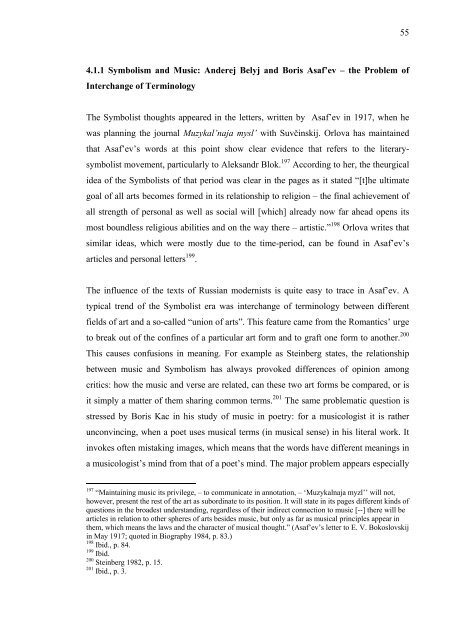Boris Asaf'ev and the Soviet Musicology - E-thesis
Boris Asaf'ev and the Soviet Musicology - E-thesis
Boris Asaf'ev and the Soviet Musicology - E-thesis
Create successful ePaper yourself
Turn your PDF publications into a flip-book with our unique Google optimized e-Paper software.
4.1.1 Symbolism <strong>and</strong> Music: Anderej Belyj <strong>and</strong> <strong>Boris</strong> Asaf’ev – <strong>the</strong> Problem of<br />
Interchange of Terminology<br />
The Symbolist thoughts appeared in <strong>the</strong> letters, written by Asaf’ev in 1917, when he<br />
was planning <strong>the</strong> journal Muzykal’naja mysl’ with Suvčinskij. Orlova has maintained<br />
that Asaf’ev’s words at this point show clear evidence that refers to <strong>the</strong> literarysymbolist<br />
movement, particularly to Aleks<strong>and</strong>r Blok. 197 According to her, <strong>the</strong> <strong>the</strong>urgical<br />
idea of <strong>the</strong> Symbolists of that period was clear in <strong>the</strong> pages as it stated “[t]he ultimate<br />
goal of all arts becomes formed in its relationship to religion – <strong>the</strong> final achievement of<br />
all strength of personal as well as social will [which] already now far ahead opens its<br />
most boundless religious abilities <strong>and</strong> on <strong>the</strong> way <strong>the</strong>re – artistic.” 198 Orlova writes that<br />
similar ideas, which were mostly due to <strong>the</strong> time-period, can be found in Asaf’ev’s<br />
articles <strong>and</strong> personal letters 199 .<br />
The influence of <strong>the</strong> texts of Russian modernists is quite easy to trace in Asaf’ev. A<br />
typical trend of <strong>the</strong> Symbolist era was interchange of terminology between different<br />
fields of art <strong>and</strong> a so-called “union of arts”. This feature came from <strong>the</strong> Romantics’ urge<br />
to break out of <strong>the</strong> confines of a particular art form <strong>and</strong> to graft one form to ano<strong>the</strong>r. 200<br />
This causes confusions in meaning. For example as Steinberg states, <strong>the</strong> relationship<br />
between music <strong>and</strong> Symbolism has always provoked differences of opinion among<br />
critics: how <strong>the</strong> music <strong>and</strong> verse are related, can <strong>the</strong>se two art forms be compared, or is<br />
it simply a matter of <strong>the</strong>m sharing common terms. 201 The same problematic question is<br />
stressed by <strong>Boris</strong> Kac in his study of music in poetry: for a musicologist it is ra<strong>the</strong>r<br />
unconvincing, when a poet uses musical terms (in musical sense) in his literal work. It<br />
invokes often mistaking images, which means that <strong>the</strong> words have different meanings in<br />
a musicologist’s mind from that of a poet’s mind. The major problem appears especially<br />
197<br />
“Maintaining music its privilege, – to communicate in annotation, – ‘Muzykalnaja myzl’’ will not,<br />
however, present <strong>the</strong> rest of <strong>the</strong> art as subordinate to its position. It will state in its pages different kinds of<br />
questions in <strong>the</strong> broadest underst<strong>and</strong>ing, regardless of <strong>the</strong>ir indirect connection to music [--] <strong>the</strong>re will be<br />
articles in relation to o<strong>the</strong>r spheres of arts besides music, but only as far as musical principles appear in<br />
<strong>the</strong>m, which means <strong>the</strong> laws <strong>and</strong> <strong>the</strong> character of musical thought.” (Asaf’ev’s letter to E. V. Bokoslovskij<br />
in May 1917; quoted in Biography 1984, p. 83.)<br />
198<br />
Ibid., p. 84.<br />
199<br />
Ibid.<br />
200<br />
Steinberg 1982, p. 15.<br />
201<br />
Ibid., p. 3.<br />
55

















